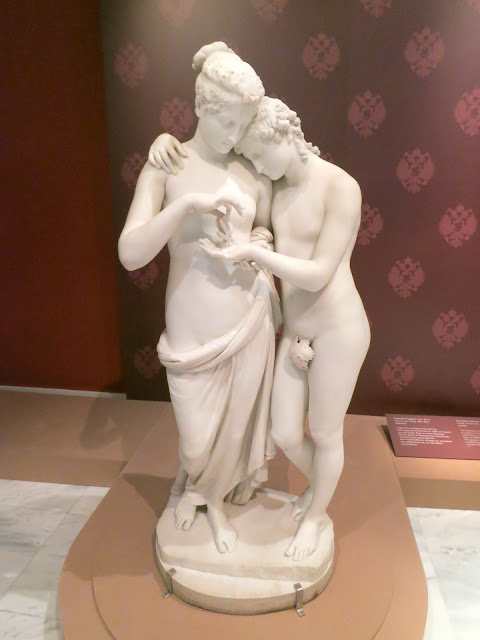
Gateway to History, Treasures from the Hermitage Museum,
at the Byzantine Museum, Athens.
Works of art from the imperial collections of the State Hermitage Museum of St Petersburg are displayed in the galleries of the Byzantine Museum.
Since the economic crisis hit Greece, museums and galleries cannot afford to exhibit the work of non-Greek artists anymore and consequently exhibitions like this one are packed. There were far too many people at the exhibition, including two huge groups, so we were constantly moving from room to room trying to avoid the crowds but we nevertheless enjoyed seeing this exhibition.
Pierre Bonnard, Landscape with a Goods Train, 1909, (oil on canvas)
Having been shaped by Impressionism, Bonnard moved to more flat, decorative, Post-Impressionistic work, establishing together with fellow artists the movement of Les Nabis. The landscape with the freight train recalls a colourful carpet and impresses with the device of the little girl featured in the painting's foreground.
Eugene-Louis Boudin, Beach at Trouville, 1893, (oil on canvas)
Auguste Rodin, Cupid and Psyche, 1905, (marble)
Emile-Antoine Bourdelle, Dloquence, 1917, (bronze)
Chaim Soutine, Self-Portrait, 1920-21, (oil on canvas)
Friedrich Eduard Meyerheim, Good Morning, Dear Father, 1858, (oil on canvas)
Albert Edelfelt, Laundresses, 1893, (oil on canvas)
Founder of the Realist art movement in Finland, Edelfelt employs here his preferred theme, which deals with the daily life of the people of hardship and toil in an idealised composition in which the sun bathes the interior of the room and the female figures are depicted sturdy and smiling performing their everyday duties.
Franz Xaver Winterhalter, Neapolitan Siesta, 1837, (oil on canvas)

Peter Paul Rubens, Venus and Adonis, 1610-1611, (oil on panel)
Anthony Van Dyck, Portrait of Lady Jane Goodwin 1639, (oil on canvas)
Circle of Michelangelo Merisi da Caravaggio, Bacchus, 1610, (oil on canvas)
Master of the Female Half-Lengths, Female Musicians, (oil on panel)
The subject of the unknown painter or group of painters of Dutch painting of the first half of the 16th century was particularly popular with the bourgeois clientele of the time period. The female musicians serve as an allegory of love, as indicated by the verses on the sheet music in the painting's foreground.
Antonio Canova, Cupid and Psyche, 1801-1903, (marble)
Leo von Klenze, Palace in Athens, 1835, (oil on canvas)
Leo von Klenze was a neoclassicist architect who worked in the court of King Ludwig I of Bavaria and was invited to design the residence of his son Otto, the first king of Greece. The painting depicts the architect's proposal for the royal residence at Athens which was never implemented.
Bernard Buffet, The Winter Palace, 1992, (oil on canvas)
















No comments:
Post a Comment